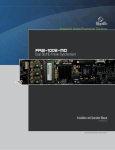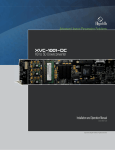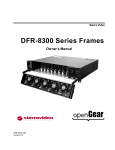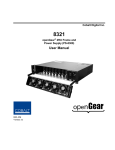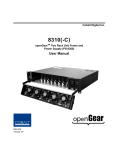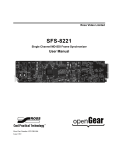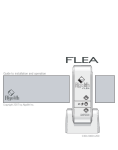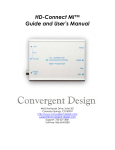Download Algolith Dual SD/HD Video Delay VLD-1002-MD Specifications
Transcript
Advanced Image Processing Solutions Dual SD/HD Video Delay Installation and Operation Manual C3034-8001-100 Copyright Algolith 2008, all rights reserved Guide to installation and operation VLD-1002-MD Table of Contents Safety ...........................................3 Specifications ..............................28 Introduction ...................................4 Limited Warranty .........................29 Overview ............................................... 4 Main Features ........................................ 4 The Algogear Series ............................... 5 Contact us ..................................29 Installation and setup .....................6 Static Discharge..................................... 6 Board Installation ................................... 6 Installation and setup .....................7 Power Consumption ............................... 8 Front Module.......................................... 8 Rear Input / Output Module Labels .......... 9 Output Channels ................................... 10 Controls .............................................. 11 Product Status Area ............................. 11 Basic Tree View ................................... 11 Operation ....................................11 The Dashboard Software Interface.............. 11 The Basic Tree View Window ................. 12 The Product Status Area ....................... 12 The Card Info Window ........................... 12 The Card Status Window ....................... 12 The Card License Window ..................... 13 Control ................................................ 13 Login to administrator level ................... 14 Adjusting Parameters ................................ 14 The Administrator Level ........................ 14 Recall & apply settings ......................... 15 Save settings ....................................... 15 The Card Setup Window ....................... 15 Selecting the Reference ........................ 16 Video Setup Window ............................. 18 The Alarm Setup Window ...................... 21 How to Repurpose your Card ........22 Load the new product onto your card ......... 23 2 VLD-1002-MD Guide to installation and operation Safety Electromagnetic Compatibility Before using this product, carefully review all the safety precautions in this user guide, and all the important regulatory and safety notices in the openGear DFR8310-C Multi-Definition Digital Products Frame User Manual. CAUTION This symbol is intended to alert the user to the presence of uninsulated “dangerous voltage” within the product’s enclosure that may be of sufficient magnitude to constitute a risk of electric shock to persons. This symbol is intended to alert the user to the presence of important operating and maintenance (servicing) instructions in the literature accompanying the appliance. Restrictions on Hazardous Substances Directive 2002/95/EC—commonly known as the European Union (EU) Restriction on Hazardous Substances (RoHS)—sets limits on the use of certain substances found in electrical and electronic equipment. The intent of this legislation is to reduce the amount of hazardous chemicals that may leach out of landfill sites or otherwise contaminate the environment during end-of-life recycling. The Directive takes effect on July 1, 2006, and it refers to the following hazardous substances: This equipment has been tested and found to comply with the limits for a class A digital device, pursuant to part 15 of the FCC Rules. These limits are designed to provide reasonable protection against harmful interference when this equipment is operated in a commercial environment. This equipment generates, uses and can radiate radio frequency energy and, if not installed and used in accordance with the instructions, may cause harmful interference to radio communications. Operation of this equipment in a residential area is likely to cause harmful interference in which case users will be required to correct the interference at their own expense. Changes or modifications to this equipment not expressly approved by Algolith Inc. could void the user’s authority to operate this equipment. Waste from Electrical and Electronic Equipment (WEEE) Compliance The European Union (EU) Directive 2002/96/EC on Waste from Electrical and Electronic Equipment (WEEE) deals with the collection, treatment, recovery, and recycling of electrical and electronic waste products. The objective of the WEEE Directive is to assign the responsibility for the disposal of associated hazardous waste to either the producers or users of these products. Effective August 13, 2005, producers or users will be required to recycle electrical and electronic equipment at end of its useful life, and may not dispose of the equipment in landfills or by using other unapproved methods. (Some EU member states may have different deadlines.) Equipment that complies with the EU directive will be marked with a WEEE-compliant emblem, as shown in the figure below. • Lead (Pb) • Mercury (Hg) • Cadmium (Cd) • Hexavalent Chromium (Cr-V1) • Polybrominated Biphenyls (PBB) • Polybrominated Diphenyl Ethers (PBDE) According to this EU Directive, this product is fully RoHS-compliant and “lead-free.” Please insure that this equipment is properly recycled at its end-of-life. Algolith invites you to contact your local or regional waste administration if you need any information on how to dispose of this equipment in an environmentally friendly and health conscious manner. 3 Guide to installation and operation VLD-1002-MD Introduction Overview The Algogear VLD-1002-MD Video Delay is designed for delay applications in both standard and high-definition SDI environments on up to 2 channels. It supports all popular standard-definition and high-definition video formats including 480i59.94, 576i50, 720p50, 720p59.94, 720p60, 1080i50, 1080i59.94 and 1080i60. Delay programming can be added in time units (seconds) and video units (frames). The VLD-1002-MD provides up to 4 seconds of delay in HD and 24 seconds in SD with the optional 2 GB SODIMM (Small Outline Dual Inline Memory Module). The VLD-1002-MD will automatically delay all 16 channels (4 groups) of embedded audio to compensate for the video delay. In addition, ancillary data, closed caption and time code information are also delayed according to video. Main Features • • • • Dual channel SD/HD video delay Dual outputs per channel, output format follows input format Delay programming in time units (seconds) and video units (frames) Up to 4 seconds of delay for HD and up to 24 seconds of delay for SD, at 2GB memory in a 2 channel configuration • Passes Ancillary Data (including embedded audio) • SNMP Support • Controlled by easy-to-use DashBoard software Output 1A Input 1 Variable Delay Buffer Input 2 Output 1B Output 2A Output 2B Card Ref Frame Ref 1 Frame Ref 2 4 Genlock Control VLD-1002-MD Guide to installation and operation The Algogear Series Designed for openGear, Algogear is a flexible, future-proof, modular solution that can maximize bandwidth, clean, synchronize and scale media. Algogear delivers unparalleled value and flexibility to broadcasters leveraging the Algogear solution, giving the ground-breaking ability to reprogram the cards with any of the available Algogear solutions at any time, at no cost. If you have a simple configuration that will change as your needs evolve, you can continue to change the functionality of the Algogear cards, reconfiguring them to meet your needs over time. The list of Algogear applications is quickly evolving. Visit www.algolith. com for a current list of available applications and news about products coming soon. Card Identification Rear module labels and card identification labels for each Algogear application available at the time of purchase are included with your card. In addition, an installation CD is provided which includes the user guides of all Algogear applications available at the time of purchase. To request additional rear module labels, card identification labels and user guides email us at [email protected]. See the «How to Repurpose your Algogear Card» section of this manual for more information (page 22). 5 Guide to installation and operation VLD-1002-MD Installation and setup Static Discharge Whenever handling the VLD-1002-MD and other related equipment, please observe all static discharge precautions as described in the following note: Static discharge can cause serious damage to sensitive semiconductor devices. Avoid handling circuit boards in high static environments such as carpeted areas, and when wearing synthetic fiber clothing. Always exercise proper grounding precautions when working on circuit boards and related equipment. Board Installation Use the following procedure to install the VLD-1002-MD in an openGear (DFR-8310-N) distribution frame with cooling fans: Due to power consumption and heat dissipation requirements, the VLD1002-MD must only be installed in a frame with the cooling fan option installed. 1. Refer to the User Manual of the openGear 8300 series frame to ensure that the frame is properly installed according to instructions. 2. A maximum of 8 VLD-1002-MD or other Algogear cards can be installed in the DFR-8310 series frame. Do not populate the openGear frame with more than 8 Algogear cards. Attempting to do so may damage the cards, the frame or both. 3. 6 After selecting the desired frame and installation slot, hold the VLD-1002-MD card by the edges and carefully align the card edges with the slots in the frame. Then fully insert the card into the frame until the rear connection plugs are properly seated on the midplane and rear modules. VLD-1002-MD Guide to installation and operation Installation and setup The VLD-1002-MD card is installed in the openGear frame. openGear frame The VLD-1002-MD card requires a BNC rear output module. Depending on the frame model you purchased, your frame may be equipped with a fixed 100 BNC rear panel. openGear frame with a fixed 100 BNC rear panel Your frame model may have a modular rear panel, to accommodate different types of cards. You will then need to purchase and install a 10 BNC single rear module for each VLD-1002-MD card in your openGear frame. openGear frame with a modular rear panel For information on the openGear frame and how to install your VLD-1002MD card and your rear modules, see the DFR-8310-C Multi Definition Digital Products Frame and Power Supply (PS-8300) User Manual, provided with your installation CD. 7 Guide to installation and operation VLD-1002-MD Power Consumption The power rating of the openGear frame allows 125 watts to be redistributed over 10 slots. A single slot may exceed 12 watts but the overall power consumption shall not be above 125 watts. The VLD-1002-MD dissipates 14 watts. An openGear frame, when populated with Algogear cards only shall use no more than 8 slots. Blank slot fillers can be used to block slots in an openGear frame. A warning message is affixed to the VLD-1002-MD card and other Algogear cards to ensure the user is aware of the card’s power consumption when installing new systems, or rearranging frame configurations. openGear frame Blocked frame slot Algogear cards ALGOGEAR DO NOT REMOVE ALGOGEAR ALGOGEAR Front Module The VLD-1002-MD card is identified with a product label located near the card’s front edge. When installed in a frame and powered, the card displays the product name on a dot matrix display. See drawing below. Card status (DS1) ALGOGEAR 8 VLD1 002M VLD-1002-MD Input 1 status (DS2) Input 2 status (DS3) Not used on VLD-1002-MD (DS4) Not used on VLD-1002-MD (DS5) Card reference status (DS6) Dot matrix display Product label VLD-1002-MD Guide to installation and operation 6 status LEDs are located near the VLD-1002-MD card’s front edge. Consult the graphic and color code below to identify the LEDs and their meanings. Card Status - LED color code Green Yellow Red Normal Minor Problem Critical error Rear Input / Output Module Labels Algolith’s VLD-1002-MD card comes with the rear module labels of every available Algogear product at the time of purchase. To identify your card and the connectors at the back of the openGear frame, simply push the appropriate label onto the BNC connectors to identify the card’s inputs and outputs. 3 4 T1 INPU FILL 1 3 4 000-SD VNR-1 B 1A 1 1C 1 SAFE C 001-U XVC-1 Select the appropriate label Push onto connectors Rear label VLD-1002-MD BNC 1 Input 1 Input 2 BNC 2 BNC 3 No Connection No Connection BNC 4 BNC 5 Output 1A Output 2A BNC 6 BNC 7 Output 1B Output 2B BNC 8 BNC 9 No Connection Reference BNC 10 9 Guide to installation and operation VLD-1002-MD Output Channels The VLD-1002-MD has 2 HD/SD-SDI inputs and 4 HD/SD-SDI outputs. Each channel in the Dashboard user interface corresponds to the matching input number. The label on the card’s BNC rear output module, at the back of the openGear frame, identifies the inputs and outputs. INPUTS 1 DASHBOARD USER INTERFACE Channel 1 OUTPUTS 1A 1B 2A 2 10 Channel 2 2B VLD-1002-MD Guide to installation and operation Operation Once installed in the openGear frame, the VLD-1002-MD card is controlled through the Dashboard software (version 2.2 or higher). For information on how to install the software and to manage openGear frames in Dashboard, please consult the Dashboard Software User Manual, provided on the installation CD you have received with this purchase, or visit our website at: http://www.algolith.com/support/ documentation The Dashboard Software Interface Dashboard is the openGear frame’s graphical user interface. Users can remotely access and operate the VLD-1002-MD card through the Dashboard software. The graphic below illustrates the basic window structure of the interface. Basic Tree View Selected Frame & Card Product Status Area Card Info, Card Status & Card License Controls In Dashboard, values displayed in yellow fields cannot be modified as they are «read only». 11 Guide to installation and operation VLD-1002-MD The Basic Tree View Window All openGear frames and compatible cards in your system are displayed in the Basic Tree View window. Select the card you wish to control in the Basic Tree View window. For more information on the device list please consult the Dashboard Software User Manual. The Product Status Area The product status area of the Dashboard interface displays the selected card’s product name, the card’s status (i.e. OK, Upgrade in Progress, Alarm, or Error) and connection status (i.e. Online or Offline). The Card Info Window The Card Info window displays the product and manufacturer’s name, and information that may be useful for maintenance, such as the assembly information, unit MAC address and firmware information. The Card Status Window The Card Status window displays the input video format for each channel, and the reference video input. 12 VLD-1002-MD Guide to installation and operation The Card License Window In order to be able to repurpose your Algogear card, a license must be available within the card for the Algogear product you want to switch to. The Card License Window displays the Algogear product that were available at the time of your purchase, and for which you have a license. For more information on how to repurpose your Algogear card, see the «How to Repurpose your Algogear Card» section, on page 22. Control The user can control the VLD-1002-MD’s various parameters in the Card Setup, Video Setup and Alarm Setup windows. The following section describes how to adjust these parameters. 13 Guide to installation and operation VLD-1002-MD Adjusting Parameters The VLD-1002-MD card provides an extra level of control and security with an administrator password-protected level, in which the parameters of the card can be modified and controlled. The non password-protected level or «read only» mode, where no password is entered, allows users to view the various settings, but does not permit changes to be made. The Administrator Level To protect against unwanted modification of operating parameters, the interface provides an administrator level (password-protected) mode which allows users the right to modify card settings. Admin Login The Admin Login section can be found in the Card Setup window. Enter the password «algolith» to gain full access to the administrator level. Once the password is entered, the Card Setup window changes to allow modification to the various settings. Allow a few seconds for the password login to take effect. The administrator mode remains active until you click the Logout button. Admin Logout Use the Logout button to quit the administrator level. Once you have logged out, the Card Setup window reverts back to the «read only» mode and the preset settings cannot be modified. Allow a few seconds for the logout to take effect. Login to administrator level 14 VLD-1002-MD Guide to installation and operation The Card Setup Window The Card Setup window allows the configuration of parameters affecting the overall functionality of the card. Recall & apply settings Save settings Save Settings Destination The Save Settings Destination function allows the user to save up to 4 configurations of the VLD-1002-MD card’s parameters per channel. Once you have configured the card to your liking in the Video Setup and Audio Setup tabs of the Dashboard interface, select a name under which the configuration will be saved, beside the Save Settings Destination function, and hit the Save button. Parameters can be saved as: • • • • • All (applies the settings to User 1, 2, 3 and 4) User 1 User 2 User 3 User 4 Settings can be saved by channel (1 or 2), or for both channels together (All) in the Save Settings Source section. Channel Settings Once the parameters are saved to memory, the configuration becomes available as a preset in the Channel 1 Settings or Channel 2 Settings drop down menus. Factory settings can be restored by selecting Default in the Channel 1 Settings or Channel 2 Settings drop down menus. The preset applies to the selected channel only. The preset is applied immediately. Following boot up of the card, the settings are automatically restored from the channel selected settings. 15 Guide to installation and operation VLD-1002-MD Selecting the Reference The VLD-1002-MD card provides four methods for referencing the incoming video signal. At the bottom of the Card Setup window, the reference selection can be chosen from a drop down menu. The reference selection is automatically saved and will be restored after power-up. The VLD-1002-MD accepts tri-level, bi-level and black burst reference signals. The video inputs can be synchronized with the house sync signal. The VLD-1002-MD card synchronizes the video input 1 and the video input 2 with the same reference signal. Therefore, it is mandatory for input 1 and input 2 to be of the same video format. Reference Selection The Reference Selection function allows the user to select from 4 possible synchronization signals. Select from: Internal Ch1: Extracts the reference from the channel 1 (input 1) video signal. With this selection, the VLD-1002-MD card needs a valid video signal at input 1 to properly synchronize. If you are only connecting one video signal to the VLD-1002-MD card’s rear module, use input 1. External 1 (Frame Ref 1): The openGear frame has a distributed frame reference, allowing a single incoming reference sync signal to feed information to all modules in a frame. External 1 uses the reference signal from the openGear frame’s REF 1 input. External 2 (Frame Ref 2): Uses the reference signal from the openGear frame’s REF 2 input. 16 16 VLD-1002-MD Guide to installation and operation External Card (BNC 10): Uses the reference signal from the VLD-1002MD card’s rear module REF input. RossBus VLD-1002-MD rear module ETHERNET PSU 2 openGear PSU 2 DFR-8310 openGear Frame REF1 LOOP REF2 LOOP External 2 (Frame ref 2) External 1 (Frame ref 1) Internal Ch1 (BNC 1) External Card (BNC 10) 17 Guide to installation and operation VLD-1002-MD Video Setup Window The Video Setup window allows the configuration of video parameters affecting the individual channels of the card. Video Default Mode The Video Default mode function is used if no valid video is detected at the input. The VLD-1002-MD can be set to respond to these problems with the Video Default Mode function. Select from: • Last good frame • Last good field • Black (output image freezes to the last good frame) (output image freezes to the last good field) (a black image is generated at the output) Video Format The Video Format function allows the user to manually override the detected input video format and force another format at the output. Users may select from: • • • • • • • • • 18 Auto 480i59.94 576i50 720p50 720p59.94 720p60 1080i50 1080i59.94 1080i60 VLD-1002-MD Guide to installation and operation Video Delay The Video Delay function allows users to adjust the video delay in increments of frames and seconds. Video Delay (sec) The Video Delay (sec) function allows users to adjust the video delay in increments of one second. The following table lists the possible values according to the video format: Format Video Delay (sec) values 408i59.94 1 - 24 576i50 1 - 24 720p50 1-4 720p59.94 1-4 720p60 1-4 1080i50 1-4 1080i59.94 1-4 1080i60 1-4 Video Delay (frame) The Video Delay (frame) function allows users to adjust the video delay in increments of one frame. The following table lists the possible values according to the video format: Format Video Delay (frame) values 408i59.94 1 - 29 576i50 1 - 24 720p50 1 - 49 720p59.94 1 - 59 720p60 1 - 59 1080i50 1 - 24 1080i59.94 1 - 29 1080i60 1 - 29 19 Guide to installation and operation VLD-1002-MD Maximum Delay in Seconds & Frames The maximum video delay per channel varies with the input video’s frame rate, and is reached with the following settings in seconds and frames: Video Format Maximum delay Seconds Frames 480i59.94 24 15 576i50 24 15 720p50 4 25 720p59.94 4 31 720p60 4 31 1080i50 4 12 1080i59.94 4 15 1080i60 4 15 Video Delay - Apply In order for your settings to be applied, you must check the Video Delay - Apply check box. The video delay is not automatically applied to your input video while you are changing the values in the seconds and frames fields of the dialog box. 20 VLD-1002-MD Guide to installation and operation The Alarm Setup Window Alarms reported to Dashboard Problems detected by the VLD-1002-MD card are transmitted as alarms to the card’s LED, to the Dashboard interface, and to the optional SNMP monitoring. The problems detected can be reported to the user as minor alarms or critical alarms. Alarms reported to card’s LED Card status (DS1) Input 1(DS2) Input 2 (DS3) Not used (DS4) Not used (DS5) Card Reference (DS6) ALGOGEAR The Alarm Setup window allows the user to set the alarm level at which many types of errors will be reported to the LEDs or to Dashboard, independently for channel 1 and 2, for the reference signal and for the license key detection. The alarm signals can also be disabled. Minor: When the alarm level for a specific type or error is set to minor, the card’s LED will report the problem with a yellow light and Dashboard with a yellow circle next to an error message describing the problem. Critical: When the alarm level for a specific type or error is set to critical, the card’s LED will report the problem with a red light and Dashboard with a red circle next to an error message describing the problem. Carrier and video detection errors on input 1 are always reported as critical and cannot be set otherwise. The Alarm Setup settings are automatically saved to memory and are recalled after a power-up. 21 Guide to installation and operation VLD-1002-MD How to Repurpose your Algogear Card Algogear cards are easy to reconfigure. First, visit our website in the support section, at: http://www.algolith.com/support/downloads/ repurpose-algogear You will find a list of the Algogear products available for you. Select the Algogear solution you would like to download onto your existing Algogear card. Next enter your name and email address and press the Download Solution button. An email will be sent to you with a link to retrieve the download file for your new Algogear application. Save the file on the PC which you will use to run Dashboard and access the Algogear card you want to repurpose. You are now ready to load the application onto your Algogear card. 22 VLD-1002-MD Guide to installation and operation Load the new product onto your card The instructions below will help you quickly and easily repurpose your Algogear card with a new Algogear application. Please take the time to read through the steps before beginning the process so that you have all the necessary information on hand before you begin. 1. Repurposing an Algogear card can only be done through the Dashboard software application (to download Dashboard visit http://www.algolith.com/support/downloads/index.html). In order to repurpose your Algogear card, you will need to be able to access it in Dashboard. 2. Before you repurpose your Algogear card with a new application, view the application licenses that are authorized to run on your Algogear card by selecting the Card License info tab in Dashboard. Select the card you want to repurpose The selected card can be repurposed to any of the Algogear products listed in the Card License tab Click on the Upload button to select the .BIN file you have downloaded from Algolith’s website NOTE: If you cannot find the license for the application you want to program the card with, or you cannot find the Card License info tab, STOP IMMEDIATELY and call Algolith customer support at: 1.877.ALGOLITH ext 3509. 3. Now that you have validated the license, you are ready to repurpose your Algogear card with the .BIN file you have downloaded. 23 VLD-1002-MD Guide to installation and operation 4. Next you will need to upload the downloaded file onto the Algogear card. Click on the Upload button to select the .BIN file in the directory in which it is stored, and click the Open button. Click Upload to get to the .BIN file You will get a confirmation dialog box that displays the selected upload file name, type, size, and the file creation date. Click on Continue to start the uploading process (an Uploading Progress dialog box opens). NOTE: Pressing the Cancel button while uploading will leave the card in an invalid state. Do not click Cancel unless the uploading progress has stopped completely for 60 seconds or more. The uploading process can take a few minutes. 24 Guide to installation and operation VLD-1002-MD 5. Be patient! The upgrade process can take a few minutes. While the files are being decompressed, the Dashboard user interface displays an «Upgrade in Progress» message. After decompression, the files are installed and Dashboard loses connection with the card. An error message is then displayed. See graphic below. Card is in the process of being repurposed This step is normal in the upgrade process and must not be interrupted. 6. When the repurposing process is completed, Dashboard can no longer locate the functions of the initial card and the menu disapears. You will need to close the current device view in Dashboard as it is no longer valid and re-open the device from the Basic Tree View. Basic Tree View Close the device window displaying the Algogear card that is no longer valid 25 Guide to installation and operation VLD-1002-MD 7. Once the card has rebooted, you should see the name of the new Algogear product you have installed on the dot matrix display located on the board. XVC1001U Dot matrix display ALGOGEAR NOTE: If you don’t see the product name, but instead the following message: “LICENSE?”, an error has occurred with the license file and you should contact Algolith customer support immediately for assistance at 1.877.ALGOLITH ext 3509. 8. Many stickers and labels were provided with your original purchase, in order for you to be able to identify your card and the rear module BNCs correctly in the event that you repurposed your card. Select the appropriate labels and install them as follows: 001-UC 001-DC 001-UC 001-UC XVC-1 XVC-1 XVC-1 3 4 XVC-1 -DC 001-UC 001 XVC-1 001-UC XVC-1 02-MD 000-SD VNR-1 VLD-10 02-MD 000-SD VNR-1 VLD-10 02-MD FRS-10 FRS-10 02-MD 02-MD VLD-10 001-UC 001-UC 001-UC XVC-1 FILL 1 XVC-1 001-UC 001-UC XVC-1 XVC-1 -UC C-1001 001-UC 3 4 XVC-1 XV 001-UC B 1A 1 1 1C 001-UC 000-SD VNR-1 001-UC SAFE XVC-1 XVC-1 XVC-1 001-UC T1 INPU 001-UC XVC-1 XVC-1 001-UC C 001-U XVC-1 XVC-1 XVC-1 XVC-1 XVC1001U VLD-1002-MD ALGOGEAR Replace ID label on card 26 Labels of all Algogear products provided with your original purchase Replace rear module label on frame VLD-1002-MD Guide to installation and operation Congratulations, you have successfully repurposed your Algogear card. To request new rear module labels and card labels, email your name, shipping address, phone number and the Algogear applications you require at [email protected]. 27 Guide to installation and operation VLD-1002-MD Specifications* SD/HD SDI Video Signal: SD (SMPTE 259M-C) (270 Mbps) HD (SMPTE 292M) (1.485, 1.485/1001 Gbps) Formats: SD 480i59.94, 576i50 HD 720p50, 720p59.94, 720p60, 1080i50, 1080i59.94, 1080i60 Format autodetected Ancillary Data: Passthrough Video Inputs Connectors: Return Loss: Impedance: Video Outputs Connectors: Return Loss: Jitter: Impedance: Reference Connector: Two (2) BNC SD >21 dB up to 270 Mbps HD >14 dB up to 1.5 Gbps 75 Ω unbalanced Four (4) BNC SD >17 dB up to 270 Mbps HD >11 dB up to 1.5 Gbps SD < 0.2 UI HD < 0.3 UI 75 Ω unbalanced One (1) BNC, SMPTE 170 bi-level, tri-level Control: Inputs: Software: One (1) RJ-45 on frame Dashboard Emedded Audio: Automatic Detection Power: 14 W * Specifications are subject to change without notice. 28 VLD-1002-MD Guide to installation and operation Limited Warranty Limited Warranty Coverage Algolith Inc. warrants that the equipment it manufactures shall be free from defects in material and workmanship for a period of two (2) years from the date of purchase. If equipment fails due to such defects, Algolith Inc. will, at its option, repair or provide a replacement for the defective part or product. Equipment that fails after the warranty period, has been operated or installed in a manner other than that specified by Algolith, or has been subjected to abuse or modification, will be repaired for time and material charges at the Buyer’s expense. All out-of-warranty repairs are warranted for a period of ninety (90) days from the date of shipment from the factory. A purchase receipt or other proof of the original purchase date is required for warranty service. Algolith Inc. makes no other warranties, expressed or implied, of merchantability, fitness for a particular purpose or otherwise. Algolith’s liability for any cause, including breach of contract, breach of warranty, or negligence, with respect to products sold by it, is limited to repair or replacement by Algolith, at its sole discretion. In no event shall Algolith Inc. be liable for any incidental or consequential damages, including loss of profits. Contact us Algolith Inc. 400 Isabey Montréal, Québec, Canada H4T 1V3 t. 514.335.9867 t. 877.ALGOLITH f. 514.333.9873 Via Internet General Information: [email protected] Visit us at: www.algolith.com 29






























